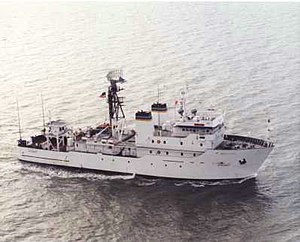
HMNZS Resolution (A14) was a hydrographic ship of the Royal New Zealand Navy (RNZN). Originally the United States Naval Ship USNS Tenacious (T-AGOS-17), the Stalwart-class ocean surveillance ship was used by the United States to locate and track Soviet submarines from 1989 to 1997, when she was transferred to the RNZN for use as a hydrographic survey ship. She served until 27 April 2012. She was subsequently sold to EGS Group, a private surveying company, and renamed RV Geo Resolution.

USNS Invincible (T-AGM-24), also known as ex-AGOS 10, is one of two tracking ships operated by the Military Sealift Command. One of the radars it carries is the Cobra Gemini dual band, X band and S band, radar.
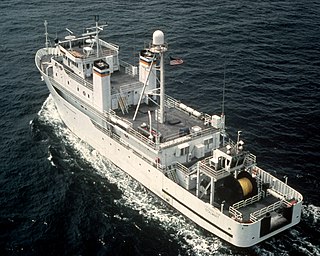
Stalwart-class auxiliary general ocean surveillance ships (T-AGOS) were a class of United States Naval Ship (USNS) auxiliary support Ocean Surveillance Ships commissioned between April 1984 and January 1990. Their original purpose was to collect underwater acoustical information using the Surveillance Towed Array Sensor System (SURTASS), a towed array passive sonar.

The AN/UQQ-2 Surveillance Towed Array Sensor System (SURTASS), colloquially referred to as the ship's "Tail", is a towed array sonar system of the United States Navy.
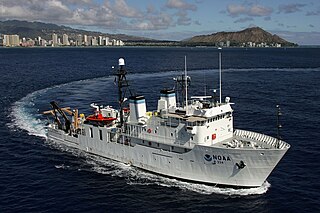
USNS Vindicator (T-AGOS-3) was a United States Navy Stalwart-class modified tactical auxiliary general ocean surveillance ship that was in service from 1984 to 1993. Vindicator then served in the United States Coast Guard from 1994 to 2001 as the medium endurance cutter USCGC Vindicator (WMEC-3). From 2004 to 2020, she was in commission in the National Oceanic and Atmospheric Administration (NOAA) fleet as the oceanographic research ship NOAAS Hi'ialakai.

USNS Triumph (T-AGOS-4) is a Stalwart-class ocean surveillance ship formerly of the United States Navy. She was struck from the Naval Vessel Register in 1995. On 1 October 2012 the ship was disposed of by Navy title transfer to the Maritime Administration. As of May 2015, Triumph was held as a reserve asset for spare parts for sister ships General Rudder and State of Michigan.

NRP Almirante Gago Coutinho (A523) is a ship of the Portuguese Navy' Dom Carlos I-class survey vessels. Before transfer to the Portuguese Navy, Almirante Gago Coutinho was formerly USNS Assurance (T-AGOS-5) of the United States Navy.

USNS Persistent (T-AGOS-6) was a Stalwart-class Modified Tactical Auxiliary General Ocean Surveillance Ship of the United States Navy.

USNS Indomitable (T-AGOS-7) was a United States Navy Stalwart-class ocean surveillance ship in service from 1985 to 2002. From 2003 until 18 June 2014, she was in commission in the National Oceanic and Atmospheric Administration (NOAA) as the oceanographic research ship NOAAS McArthur II. As of 2018 it serves as a mother ship now named the Deep Submersible Support Vessel (DSSV) Pressure Drop for the crewed deep-ocean research submersible DSV Limiting Factor.

Prevail (IX-537) is a modified Stalwart-class auxiliary general ocean surveillance ship (AGOS) of the United States Navy previously operated by the U.S. Military Sealift Command as T-AGOS 8. Prevail was reclassified as Unclassified Miscellaneous (IX) in October 2003 and is unofficially referred to as TSV-1. In this context, TSV stands for Training Support Vessel, and should not be confused with the U.S. Army's USAV Spearhead Theater Support Vessel initiative.
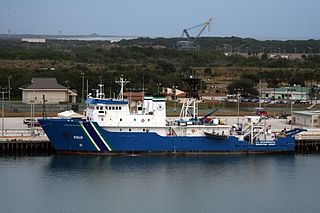
The Ocean Survey Vessel (OSV) Bold was operated by the United States Environmental Protection Agency. Originally commissioned as the USNS Vigorous, it was renamed USNS Bold (T-AGOS-12) and was a Stalwart-class Auxiliary General Ocean Surveillance Ship of the [Military Sealift Command of the United States Navy, as designated by the "T" preface to her AGOS classification]. Stalwart class ships were originally designed to collect underwater acoustical data in support of Cold war anti-submarine warfare operations in the 1980s.

The USAV Worthy (T-AGOS-14) is a Missile Range Instrumentation Ship operated by the United States Army. The USAV Worthy was a Stalwart-class Modified Tactical Auxiliary General Ocean Surveillance Ship of the United States Navy.

USNS Titan (T-AGOS-15) was a Stalwart-class modified tactical auxiliary general ocean surveillance ship in service in the United States Navy from 1989 to 1993. From 1996 to 2014, she was in commission in the National Oceanic and Atmospheric Administration (NOAA) fleet as the oceanographic research ship NOAAS Ka'imimoana.

USNS Capable (T-AGOS-16) was a Stalwart-class modified tactical auxiliary general ocean surveillance ship of the United States Navy in service from 1989 to 2004. In 2008, she was commissioned into service in the National Oceanic and Atmospheric Administration as the oceanographic research ship NOAAS Okeanos Explorer.

USNS Relentless (T-AGOS-18) was a Stalwart-class modified tactical auxiliary general ocean surveillance ship in service in the United States Navy from 1990 to 1993. Since 1998, she has been in commission in the National Oceanic and Atmospheric Administration (NOAA) fleet as the fisheries research ship NOAAS Gordon Gunter.

USNS Able (T-AGOS-20) is a Victorious-class oceanographic survey ship in the service of the United States Navy's Military Sealift Command.

USNS Hayes (T-AGOR-16/T-AG-195) was a Hayes-class oceanographic research ship acquired by the U.S. Navy in 1971. In 1992 she was reconfigured as an acoustics research ship and assigned to the Navy's program of acoustic noise reduction for submarines.

USNS Victorious (T-AGOS-19) is a Victorious-class ocean surveillance ship which was acquired by the U.S. Navy in 1991 and assigned to the Military Sealift Command (MSC) Special Missions Program.
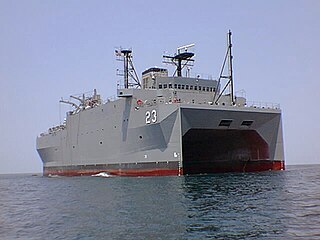
USNS Impeccable (T-AGOS-23) is an Impeccable-class ocean surveillance ship acquired by the U.S. Navy in 2001 and assigned to Military Sealift Command's Special Missions Program.

The Impeccable-class ocean surveillance ship is a single-ship class of United States Navy special mission-support ship. The original intention was to build six undersea ocean-surveillance ships carrying a SURTASS passive towed array and a Low Frequency Active transducer array. Only the lead ship, USNS Impeccable (T-AGOS-23), was built.
